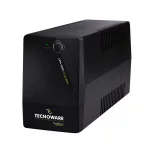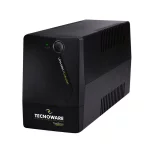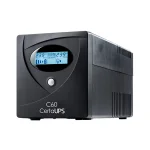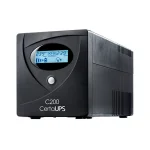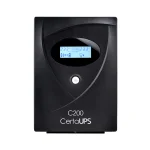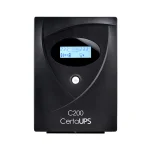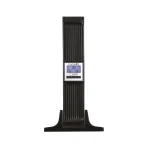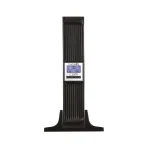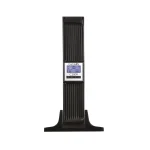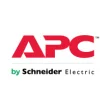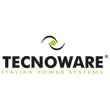A line interactive UPS is a Voltage Independent (VI) uninterruptible power supply as defined by BS EN 62040. The UPS has a built-in automatic voltage regulator (AVR) or automatic voltage stabiliser (AVS) to respond to sags, surges and brownouts, an EMC/Transient filter for spikes and electrical noise and an inverter which will generate a sinewave or pseudo sinewave output when the mains power supply fails.
Line Interactive UPS Systems
We offer a range of line interactive uninterruptible power supplies, including desktop, tower, and rack mount options, suitable for various applications such as desktop computers, workstations, CCTV, security panels, EPOS terminals, IT servers, and network routers. Line-interactive UPS systems provide power protection through power conditioning when mains power is present and battery backup through an inverter when mains power fails. This type of UPS features a transfer time of 4-6 milliseconds when switching from battery backup to power conditioning mode. An automatic voltage regulator (AVR) enables the UPS to operate within a wide input voltage range, protecting against brownouts, sags (undervoltages), and surges (overvoltages). Additionally, a filtering circuit offers extra protection from spikes and electrical noise. Choose our UPS line interactive solutions for reliable power protection and performance.
- UPS Systems (716)
- UPS Solutions (713)
- UPS Technologies (699)
- Power Distribution (333)
- Backup Power (458)
Line Interactive UPS v Standby UPS
A line-interactive uninterruptible power system is classed under IEC EN62040-3 as Voltage Independent (VI). The UPS inverter is energised but only supports the critical load when the mains power supply fluctuates or fails completely.
This type of uninterruptible power technology is typically sized in VA (Supply Voltage x Amps) or kVA (=1000VA). Models range up to 10kVA but are limited to a single phase UPS applications.
The UPS tends to have a built-in automatic voltage stabiliser (AVS) which under normal conditions (when the mains power supply is present) protects the connected load from mains power problems including sags, surges and brownouts.
The AVS can be transformer based and sometimes referred to as a buck/boost transformer. When the input voltage is high, the transformer ‘bucks’ to reduce the output voltage and when it is high the transformer ‘boosts’ the output supply voltage. The ‘buck/boost’ transformer uses a series of transformer taps to adjust the output voltage. An AVS can also be referred to as an automatic voltage regulator (AVR). A small battery charger is built into the UPS and charges the battery set. The UPS also has a built-in EMC/filtering circuit to provide protection from mains borne interference in the form of electrical noise, spikes and transients.
If the mains supply voltage falls outside the input voltage window or the input frequency window of the AVS or AVR, the inverter section connects to the load supply line and powers the connected UPS load. The inverter draws on the DC (direct current) of the built-in battery set and inverts this into an AC waveform to power the load.
When the output section picks up the load or disconnects there is typically a 2-4mS break in electrical supply. This is well within the capacitance level of the switch mode power supply (SMPS) within a computer or server which can hold capacitance up to 15-20mS or longer.
A standby UPS is classified under IEC EN62040-3 as Voltage and Frequency Dependent (VFD). The output of standy or off-line system tracks the voltage and frequency of the input mains supply and provides a more widely fluctuacting output and battery backup when the mains power fails.
Sine Wave Output and Battery Runtime
Line-interactive systems can offer a pure sine wave output or square wave output battery power. A square wave output is sometimes referred to as a Pseudo sinewave. The output section may also be rated for long running periods at 80-100% load allowing additional battery extension packs to be connected to a rear panel connector (if available). The loads are generally connected using IEC320 sockets.
Line-interactive UPS Systems
Offer super performance to standby/offline backup power solutions but they do not include the automatic bypass feature of online UPS systems. Full load runtimes will be relatively short due to the compact size of the product and a built-in battery (which may be user replaceable). Long runtimes can be achieved by oversizing a this type of system or adding, where possible, battery extension packs.
Online UPS
Online double-conversion UPS offer superior performance to line-interactive systems as the have a constantly running sinewave inverter and automatic bypass feature. That said online systems are more expensive than line-interactive.
Available line-interactive models and brands from Server Room Environments include APC by Schneider, CertaUPS, Eaton, Riello and Vertiv.
UPS Accessories
In addition to the UPS, we supply a range of UPS accessories to further customise the UPS for your application. These include SNMP interface cards, UPS maintenance bypasses (wall and 19inch rack mount), power distribution units and socket strips for additional load connection.
UPS Battery Replacement
The batteries used in these interactive power systems have a 5year design life and under normal conditions will requirement replacement in years 3-4. The ideal room operating temperature for this length of life is 20-25degrees Centigrade.
When your batteries require replacement, Server Room Environments can provide battery replacement sets for you to fit where the batteries are user-replaceable. We also provide a battery replacement service. A full eco-friendly battery disposal service is also available to ensure materials are reclaimed for later usage.
Input and Output Sockets
UPS systems up to 3kVA have plug-in power cords with a plug connection. In the UK these UPS are supplied with a BS-style 3-square pin plug. Output from the UPS to the connected loads is made using C13-C14 power cords. At least one power cord is supplied with each UPS. Additional power cords can be purchased as required. We also supply an IEC power strip extension. This connects into a UPS outlet socket and provides 4x UK style socket outlets. IEC C13/C14 socket outlets are rated at 10Amps, and it is important to ensure that the connected loads do not overload the connected outlet. The UPS may also provide a load shedding functionality. This allows user to group loads into those to be protected during a mains power failure with battery backup and those that only receive a filtered and power conditioned supply when the mains power supply is present. This provides protection for critical power and essential loads whilst ensuring that critical loads receive the maximum battery runtime during a power outage.
UPS Shutdown Software
Each UPS has a communications interface which can include USB, RS232 and/or a plug-in communications card slot. The most commonly installed comms card is for SNMP. This allows the UPS to be connected to the local IP network. Once connected to a computer or network, UPS monitoring and control software can be used to display important information including load and battery status, and initiate an orderly shutdown of the protected computer or server(s) before the battery is exhausted during a power outage.

Earn SRE points on all online purchases with double points on selected products





























